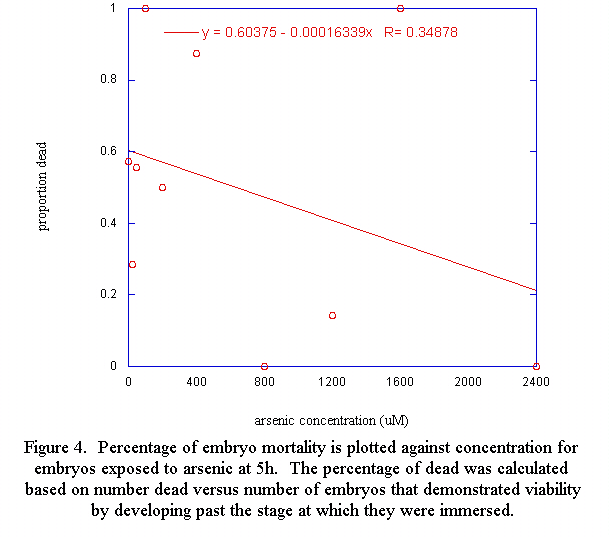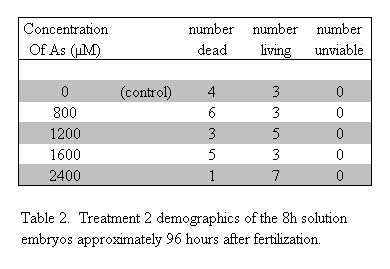|
|
|
Results continued (page 2)
Treatment
2: effect of arsenic in solution on embryos
Embryos were exposed to sodium arsenate at 5h (approximately high
oblong stage) and 8h (50%-90% epiboly stage) after fertilization.
Concentrations of arsenic used for the 5h group were 25 uM, 50 uM,
100 uM, 200 uM, 400 uM, 800 uM, 1200 uM, 1600 uM, and 2400 uM. Embryos
in the 8h group were subjected to 800 uM, 1200 uM, 1600 uM, and 2400
uM. In addition, there was one control group of embryos in zebrafish
embryo solution. At 24 hours after fertilization, all embryos were
staged between 25 hpf and 31 hpf and appeared alive and healthy. Cell
blebbing in the 5h 100 uM group was occurring while embryos were being
observed. No other instances of cell blebbing occurred (Figure 2).
At 96 hours after fertilization, embryo mortality was observed (Figure
3) although not in a significant pattern (R=0.34878 for mortality
at 5h, R=0.68875 for mortality at 8h) (Figures 4 and 5 and Tables
1 and 2). Cell blebbing in the eye was noticed in the 8 hr 1200 uM
solution (Figure 3B).

Figure 2. Zebrafish embryos observed during
treatment 2. All of the embryos were staged around 60 hpf when viewed at 48
hours (A). Apparently
spontaneous eye blebbing occurred while embryos in the 5h 100 µM
solution were being observed under the dissecting microscope (B and
C).

Figure 3. Embryos in treatment 2. After 96 hours many
of the embryos had died and partially degraded, including those
in the 5h 400 µM
solution (A). Eye blebbing was observed among some of the dead embryos
in the 8h 1200 µM solution (B).




  
[Lab
Protocols
| Students
| Cebra-Thomas
| Course
| Links
]
|
|